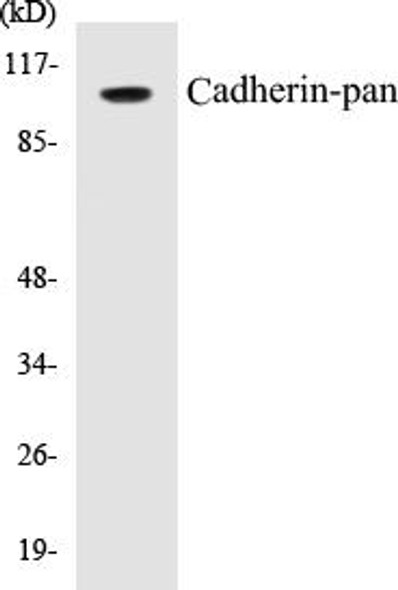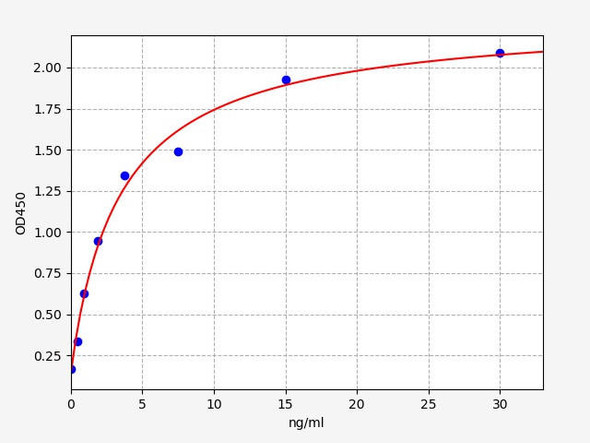Description
VE-Cadherin Colorimetric Cell-Based ELISA Kit
The VE-Cadherin Colorimetric Cell-Based ELISA Kit from Assay Genie is specifically designed for the accurate measurement of VE-cadherin levels in cell culture supernatants. This kit offers high sensitivity and specificity, ensuring reliable and reproducible results for a variety of research applications.VE-cadherin is a key protein involved in cell adhesion and plays a critical role in maintaining vascular integrity and regulating endothelial cell functions. Dysregulation of VE-cadherin has been implicated in various diseases, including cancer, cardiovascular disorders, and inflammatory conditions, making it a valuable biomarker for studying these diseases and potential drug development.
With the VE-Cadherin Colorimetric Cell-Based ELISA Kit, researchers can confidently measure VE-cadherin levels in their samples with precision and accuracy, further advancing our understanding of vascular biology and disease pathogenesis.
| Product Name: | VE-Cadherin Colorimetric Cell-Based ELISA |
| Product Code: | CBCAB00205 |
| ELISA Type: | Cell-Based |
| Target: | VE-Cadherin |
| Reactivity: | Human, Mouse |
| Dynamic Range: | > 5000 Cells |
| Detection Method: | Colorimetric 450 nmStorage/Stability:4°C/6 Months |
| Format: | 96-Well Microplate |
The VE-Cadherin Colorimetric Cell-Based ELISA Kit is a convenient, lysate-free, high throughput and sensitive assay kit that can detect VE-Cadherin protein expression profile in cells. The kit can be used for measuring the relative amounts of VE-Cadherin in cultured cells as well as screening for the effects that various treatments, inhibitors (ie siRNA or chemicals), or activators have on VE-Cadherin.
Qualitative determination of VE-Cadherin concentration is achieved by an indirect ELISA format. In essence, VE-Cadherin is captured by VE-Cadherin-specific primary antibodies while the HRP-conjugated secondary antibodies bind the Fc region of the primary antibody. Through this binding, the HRP enzyme conjugated to the secondary antibody can catalyze a colorimetric reaction upon substrate addition. Due to the qualitative nature of the Cell-Based ELISA, multiple normalization methods are needed:
| 1. | A monoclonal antibody specific for human GAPDH is included to serve as an internal positive control in normalizing the target absorbance values. |
| 2. | Following the colorimetric measurement of HRP activity via substrate addition, the Crystal Violet whole-cell staining method may be used to determine cell density. After staining, the results can be analysed by normalizing the absorbance values to cell amounts, by which the plating difference can be adjusted. |
| Database Information: | Gene ID: 1003, UniProt ID: P33151, OMIM: 601120, Unigene: Hs.76206 |
| Gene Symbol: | CDH5 |
| Sub Type: | None |
| UniProt Protein Function: | CDH5: Cadherins are calcium dependent cell adhesion proteins. They preferentially interact with themselves in a homophilic manner in connecting cells; cadherins may thus contribute to the sorting of heterogeneous cell types. This cadherin may play a important role in endothelial cell biology through control of the cohesion and organization of the intercellular junctions. It associates with alpha-catenin forming a link to the cytoskeleton. Acts in concert with KRIT1 to establish and maintain correct endothelial cell polarity and vascular lumen. These effects are mediated by recruitment and activation of the Par polarity complex and RAP1B. Required for activation of PRKCZ and for the localization of phosphorylated PRKCZ, PARD3, TIAM1 and RAP1B to the cell junction. Interacts via cadherin 5 domain with PTPRB. Interacts with TRPC4. Interacts with KRIT1. Endothelial tissues and brain. |
| UniProt Protein Details: | Protein type:Motility/polarity/chemotaxis; Cell adhesion; Membrane protein, integral Chromosomal Location of Human Ortholog: 16q22.1 Cellular Component: adherens junction; tight junction; membrane; integral to membrane; plasma membrane; intercellular junction; cell junction Molecular Function:protein binding; beta-catenin binding; calcium ion binding; protein phosphatase binding; receptor binding Biological Process: intercellular junction assembly and maintenance; negative regulation of cell proliferation; vascular endothelial growth factor receptor signaling pathway; homophilic cell adhesion; blood vessel maturation |
| NCBI Summary: | This gene is a classical cadherin from the cadherin superfamily and is located in a six-cadherin cluster in a region on the long arm of chromosome 16 that is involved in loss of heterozygosity events in breast and prostate cancer. The encoded protein is a calcium-dependent cell-cell adhesion glycoprotein comprised of five extracellular cadherin repeats, a transmembrane region and a highly conserved cytoplasmic tail. Functioning as a classic cadherin by imparting to cells the ability to adhere in a homophilic manner, the protein may play an important role in endothelial cell biology through control of the cohesion and organization of the intercellular junctions. An alternative splice variant has been described but its full length sequence has not been determined. [provided by RefSeq, Jul 2008] |
| UniProt Code: | P33151 |
| NCBI GenInfo Identifier: | 322510142 |
| NCBI Gene ID: | 1003 |
| NCBI Accession: | P33151.5 |
| UniProt Secondary Accession: | P33151,Q4VAI5, Q4VAI6, |
| UniProt Related Accession: | P33151 |
| Molecular Weight: | |
| NCBI Full Name: | Cadherin-5 |
| NCBI Synonym Full Names: | cadherin 5, type 2 (vascular endothelium) |
| NCBI Official Symbol: | CDH5 |
| NCBI Official Synonym Symbols: | 7B4; CD144 |
| NCBI Protein Information: | cadherin-5; 7B4 antigen; VE-cadherin; cd144 antigen; endothelial-specific cadherin; vascular endothelial cadherin; cadherin 5, type 2, VE-cadherin (vascular epithelium) |
| UniProt Protein Name: | Cadherin-5 |
| UniProt Synonym Protein Names: | 7B4 antigen; Vascular endothelial cadherin; VE-cadherin; CD_antigen: CD144 |
| Protein Family: | Cadherin |
| UniProt Gene Name: | CDH5 |
| UniProt Entry Name: | CADH5_HUMAN |
| Component | Quantity |
| 96-Well Cell Culture Clear-Bottom Microplate | 2 plates |
| 10X TBS | 24 mL |
| Quenching Buffer | 24 mL |
| Blocking Buffer | 50 mL |
| 15X Wash Buffer | 50 mL |
| Primary Antibody Diluent | 12 mL |
| 100x Anti-Phospho Target Antibody | 60 µL |
| 100x Anti-Target Antibody | 60 µL |
| Anti-GAPDH Antibody | 60 µL |
| HRP-Conjugated Anti-Rabbit IgG Antibody | 12 mL |
| HRP-Conjugated Anti-Mouse IgG Antibody | 12 mL |
| SDS Solution | 12 mL |
| Stop Solution | 24 mL |
| Ready-to-Use Substrate | 12 mL |
| Crystal Violet Solution | 12 mL |
| Adhesive Plate Seals | 2 seals |
The following materials and/or equipment are NOT provided in this kit but are necessary to successfully conduct the experiment:
- Microplate reader able to measure absorbance at 450 nm and/or 595 nm for Crystal Violet Cell Staining (Optional)
- Micropipettes with capability of measuring volumes ranging from 1 µL to 1 ml
- 37% formaldehyde (Sigma Cat# F-8775) or formaldehyde from other sources
- Squirt bottle, manifold dispenser, multichannel pipette reservoir or automated microplate washer
- Graph paper or computer software capable of generating or displaying logarithmic functions
- Absorbent papers or vacuum aspirator
- Test tubes or microfuge tubes capable of storing ≥1 ml
- Poly-L-Lysine (Sigma Cat# P4832 for suspension cells)
- Orbital shaker (optional)
- Deionized or sterile water
*Note: Protocols are specific to each batch/lot. For the correct instructions please follow the protocol included in your kit.
| Step | Procedure |
| 1. | Seed 200 µL of 20,000 adherent cells in culture medium in each well of a 96-well plate. The plates included in the kit are sterile and treated for cell culture. For suspension cells and loosely attached cells, coat the plates with 100 µL of 10 µg/ml Poly-L-Lysine (not included) to each well of a 96-well plate for 30 minutes at 37°C prior to adding cells. |
| 2. | Incubate the cells for overnight at 37°C, 5% CO2. |
| 3. | Treat the cells as desired. |
| 4. | Remove the cell culture medium and rinse with 200 µL of 1x TBS, twice. |
| 5. | Fix the cells by incubating with 100 µL of Fixing Solution for 20 minutes at room temperature. The 4% formaldehyde is used for adherent cells and 8% formaldehyde is used for suspension cells and loosely attached cells. |
| 6. | Remove the Fixing Solution and wash the plate 3 times with 200 µL 1x Wash Buffer for five minutes each time with gentle shaking on the orbital shaker. The plate can be stored at 4°C for a week. |
| 7. | Add 100 µL of Quenching Buffer and incubate for 20 minutes at room temperature. |
| 8. | Wash the plate 3 times with 1x Wash Buffer for 5 minutes each time. |
| 9. | Add 200 µL of Blocking Buffer and incubate for 1 hour at room temperature. |
| 10. | Wash 3 times with 200 µL of 1x Wash Buffer for 5 minutes each time. |
| 11. | Add 50 µL of 1x primary antibodies (Anti-VE-Cadherin Antibody and/or Anti-GAPDH Antibody) to the corresponding wells, cover with Parafilm and incubate for 16 hours (overnight) at 4°C. If the target expression is known to be high, incubate for 2 hours at room temperature. |
| 12. | Wash 3 times with 200 µL of 1x Wash Buffer for 5 minutes each time. |
| 13. | Add 50 µL of 1x secondary antibodies (HRP-Conjugated AntiRabbit IgG Antibody or HRP-Conjugated Anti-Mouse IgG Antibody) to corresponding wells and incubate for 1.5 hours at room temperature. |
| 14. | Wash 3 times with 200 µL of 1x Wash Buffer for 5 minutes each time. |
| 15. | Add 50 µL of Ready-to-Use Substrate to each well and incubate for 30 minutes at room temperature in the dark. |
| 16. | Add 50 µL of Stop Solution to each well and read OD at 450 nm immediately using the microplate reader. |
(Additional Crystal Violet staining may be performed if desired – details of this may be found in the kit technical manual.)






